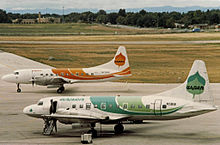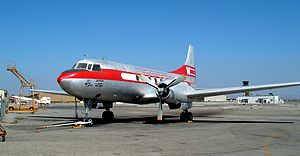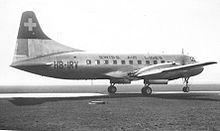- Convair CV-240 family
-
CV-240 family A restored Convair CV-240 in Western Air Lines livery, at the Planes of Fame Museum in Chino, California Role Airliner Manufacturer Convair First flight March 16, 1947 Primary user American Airlines Produced 1947–1954 Number built 1,181 Variants Convair C-131 Samaritan
Canadair CC-109 CosmopolitanThe Convair CV-240 was an American airliner produced by Convair from 1947 to 1954, initially as a possible replacement of the ubiquitous Douglas DC-3. While featuring a more modern design, the 240 series was able to make some inroads as a commercial airliner and also had a long development cycle which resulted in a number of civil and military variants. Although reduced in numbers through attrition, the "Convairliners" in various forms continue to fly into the 21st century.
Contents
Design and development
The design began life in a production requirement by American Airlines for a pressurized airliner to replace the classic Douglas DC-3. Convair's original design, the unpressurised Model 110 had two engines and space for 30 passenger seats. It first flew on July 8, 1946. American deemed the design to be too small and the aircraft NX90653 was therefore used by Convair for development work for the 240 series before being broken up in 1947.[1]
Convair's revised design "Super 240," the pressurised and stretched Model 240 was developed to accommodate 40 passengers. As the "Super 240" evolved into the CV-340, and CV-440, the limit to piston-engine performance was reached and the next developments centered on conversion to jet turboprop power which resulted in a longer operational life cycle for the type.
Operational history
The first 240 flew on March 16, 1947, and production aircraft were first delivered to American on 29 February 1948. 75 were delivered to American, with another 50 going to Western Airlines, Continental Airlines, Pan American Airways, KLM, Swissair, Sabena and Trans Australia Airlines.[2]
 Two Convair 580s of the Aspen, Colorado-based Aspen Airways at Stapleton International Airport in Denver in 1986.
Two Convair 580s of the Aspen, Colorado-based Aspen Airways at Stapleton International Airport in Denver in 1986.
A CV-240 was the first private aircraft used in a United States presidential campaign. In 1960, John F. Kennedy used a CV-240 named Caroline (after his daughter) during his campaign. This aircraft is now preserved in the National Air and Space Museum.
After the aborted negotiations with TWA and Eastern for "Super 240" orders, the production of the 240 series was temporarily halted. In response to a United inquiry, however, Convair redesigned the Super 240, calling it the CV-340. United ordered 55, and more US orders came from Braniff, Continental, Delta, Northeast and National. Other orders came from abroad, and the CV-340 proved popular in South America. The CV-340 earned an enviable reputation for reliability and profitability, and was developed into the CV-440 Metropolitan, the final piston-engined variant of the "Convairliners."
Kelowna Flightcraft Ltd. currently holds the type certificate for this aircraft.
Variants
Civil variants
- Model 110
- Unpressurized prototype with seats for 30 passengers.
- CV-240
- Initial production version. Powered by two Pratt & Whitney R-2800 engines.
-
- CV-240-21 Turboliner
- turboprop-powered conversion fitted with Allison T38 engines. It became the first turboprop airliner to fly in the United States (on December 29, 1950), but problems with the engines resulted in development being terminated and the prototype being converted back to piston power.
- CV-300
- a conversion from a Convair CV-240 with two R-2800 CB-17 engines and nacelles as used on the CV-340.[3] A CV-300 was involved in an accident that killed three members and the manager of the rock group Lynyrd Skynyrd.[4]
- CV-340
- Built for United Airlines and other operators including KLM, was basically a CV-240 lengthened to hold an additional four seats. The wing span was also extended for better performance at higher altitudes. The CV-340 replaced the DC-3 in United service. The airline flew 52 340s for 16 years without a fatality. KLM operated the type from spring 1953 until mid 1963. Many CV-340 aircraft were converted to CV-440 standard.[5]
- CV-440 Metropolitan
- CV-340 with improved soundproofing and an option of weather radar. Maximum weight rose to 49,700 lbs. An optional increase from 44 to 52 passengers was facilitated by the replacement of the carry-on luggage area with two more rows of seats, marked by the addition of an extra cabin window. This option was taken up by several airlines including Lufthansa and SAS.[5]
- Convair CV-540
- Conversion from a Convair CV-340 aircraft with two Napier Eland turboprop engines in place of the piston engines. Six aircraft were converted by Napier for Allegheny Airlines.[6]
- Convair CV-580
- conversion from Convair CV-340 or CV-440 aircraft with two Allison 501 D13D/H turboprop engines in place of the piston engines, an enlarged vertical fin and modified horizontal stabilisers. The conversions were performed by Pacific Airmotive on behalf of the Allison Engine Company.[6]
- Convair CV-600
- Conversion from a Convair 240 aircraft with Rolls-Royce Dart turboprop engines in place of the piston engines. CV-600 conversions were performed by Convair.[6] The CV-600 first flew with Central Airlines on 30 November 1965. The CV-600 aircraft that flew with Air Metro Airways was configured as a 40-passenger airliner. In August 2006, a single Convair CV-600 aircraft remains in airline service, with Rhoades Aviation.[7]
- Convair CV-640
- Conversion from a Convair CV-340 or -440 with Rolls-Royce Dart turboprop engines in place of the piston engines. The conversions were performed by Convair.[6] In August 2006, a total of nine Convair CV-640 aircraft remain in airline service, with Rhoades Aviation (three) and C&M Airways (six).[7]
- Convair CV5800
- Conversion from a C-131 Samaritan by Kelowna Flightcraft Ltd. in Canada. The CV5800 is a C-131 Samaritan stretched by 14 ft 3 in with the Samaritan's original tail unit rather than the enlarged tail of the CV-580. These conversions also have a new freight door, digital avionics with EFIS and Allison 501-D22 engines in place of the original R-2800 engines.
Military variants
- C-131 Samaritan
- The CV-240/340/440 series was used by the United States Air Force for medical evacuation and VIP under this designation
- T-29 Trainer
- A trainer model of the C-131 was used to instruct navigators and radio operators
- R4Y Samaritan
- The United States Navy used the Samaritan under this designation
- Canadair CL-66
- Conversion from CV-440, with Napier Eland turboprops in place of the piston engines. The conversions were performed in Canada by Canadair. In Canadian Air Force service they were known as the CC-109 Cosmopolitan. All were re-engined in 1966 with Allison 501-D13 engines.
Special missions and airborne testbeds
- Airborne Resources, (C-131B N131CR[8]))
- Environmental Research Institute of Michigan, later Veridian and then General Dynamics Advanced Information Systems (CV-580s N51211[9] and N51255[10])
- Honeywell International, Everett Washington (CV-580 N580AS[11])
- National Research Council (Canada) (CV-580 C-FNRC[12])
- Raytheon, Tucson Arizona (CV-580 N580HH[13])
- University of Washington, (CV-580 N3UW[14])
Operators
Civilian operators
- Aero California - CV-340
- Aerolíneas Argentinas - CV-240 (LV-ADM, LV-ADN, LV-ADO, LV-ADP & LV-ADQ)
- Aeromexico - CV-340
- Aeroquetzal - CV-580
- Air Chathams - CV-580
- Air Fiji - CV-580
- Air Freight NZ - CV-580 & CV5800
- Air Maldives - CV-440
- Air Resorts - CV-440s that were formerly operated by American Eagle
- Air Tahoma - CV-240 & CV-580
- Allegheny Airlines CV-340, CV-440, CV-540 & CV-580
- American Airlines
- Ansett Airlines - CV-340, CV-440
- Arawak - CV-440
- ARCO Aerolíneas Colonia S.A. CV-240, CV-600
- Aspen Airways CV-580
- Aviateca - CV-240, CV 440, 340
- Bar Harbor Airlines - CV-600
- Braniff International Airways - CV-340
- Buffalo Airways - CV-240
- Cal Sierra Airlines - CV-580
- Canadian Pacific Airlines - CV-240
- Central Airlines - CV-240 and CV-600
- Chathams Pacific - CV-580
- Conair Group
- Continental Airlines
- Caribair - CV-340, CV-640
- Delta Air Lines - CV-340 & CV-440
- Desert Air - CV-240
- Eastern Air Lines - CV-440
- ERA Aviation - CV-580
- Finnair CV-340 (converted to CV-440) & CV440
- Fred. Olsen Flyselskap - CV-340
- Frontier Airlines - CV-580 and CV-600
- Garuda Indonesia - CV-240, CV-340 & CV-440
- Hawaiian Airlines - CV-340, -CV-640
- IFL Group - CV-580 & CV5800
- JAT Yugoslav Airlines - CV-340 & CV-440
- Iberia Airlines - Convair CV-440
- Kar-Air CV-440
- Kelowna Flightcraft Air Charter - CV-580 & CV5800
- Kitty Hawk Aircargo - Convair 640
- KLM - CV-240 & CV-340
- LACSA - CV-340
- Líneas Aéreas Paraguayas (LAP) - 3 CV-240
- Lake Central Airlines - CV-340 & CV-580
- Linjeflyg - CV-340 & CV-440
- LOT Polish Airlines - CV-240 (5 in 1957-1966)
- Lufthansa - CV-440
- Metro Airlines - CV-580
- Mey-Air - CV-240
- Miami Air Lease - CV-440
- Midwest Air Charter/Airborne Express - CV-600
- National Airlines - CV-340 & CV-440
- Nolinor Aviation - CV-580
- Nor-Fly Charter - CV-440 & CV580
- North Central Airlines - CV-580
- Northeast Airlines - CV-240
- Northwest Airlines - CV-580
- Pacific Western Airlines - CV-640
- Pan American World Airways (Pan Am)
- Pakistan International Airlines - CV-240
- Partnair - CV-580
- Philippine Airlines - CV-340 (1950s-1960s)
- Pionair - CV-580
- Polaris Air Transport - CV-240
- Prinair - CV-580
- Quebecair - CV-540 (CL-66)
- Real Transportes Aéreos - CV-340 & CV-440
- Republic Airlines - CV-580
- Rhoades Aviaton - CV-640
- SABENA - CV-240 & CV-440
- Sahsa - CV-580
- SAS - CV-440
- Serviços Aéreos Cruzeiro do Sul - CV-240, CV340
- Sierra Pacific CV-340, CV-440 CV-580
- SMB Stage Line - Convair 640
- Stellar Airfreighter - CV-440
- Swissair - CV-240 & CV-440
- Trans-Texas Airways - CV-240 & CV-600
- Texas International Airlines - CV-600
- Toa Airways
- Trans Australia Airlines
- Transportes Aéreos Nacional - CV-440
- United Airlines
- Varig - CV-240
- Western Airlines
- Wright Airlines - CV-600
- Zantop International Airlines - Convair 640
Military operators
- Royal Australian Air Force - Two CV-440 Metropolitans (RAAF serial A95-313 and 353) were in service with RAAF from 1956 to 1968.
- Royal Canadian Air Force/Canadian Armed Forces (Canada) CV-540s were re engined with T56 turbo props with 412 Squadron
- Aeronautica Militare Italiana CV-440 Metropolitans
- Paraguayan Air Force: CV-440/C-131D
- Sri Lanka Air Force - CV-440
Other operators
Accidents and incidents
Specifications (CV-240)
Data from General Dynamics Aircraft and their Predecessors[16]
General characteristics
- Crew: 2 or 3
- Capacity: 40 passengers
- Length: 74 ft 8 in (22.76 m)
- Wingspan: 91 ft 9 in (27.97 m)
- Height: 26 ft 11 in (8.21 m)
- Wing area: 817 ft² (75.9 m²)
- Empty weight: 29,500 lb (13,410 kg)
- Max takeoff weight: 42,500 lb (19,320 kg)
- Powerplant: 2 × Pratt & Whitney R-2800 Double Wasp 18 cylinder air cooled radial engines, 2,400 hp (1,790 kW)(wet) each
Performance
- Maximum speed: 315 mph (274 knots, 507 km/h)
- Cruise speed: 280 mph (243 knots, 451 km/h)
- Range: 1,200 mi (1,043 nmi, 1,930 km)
- Service ceiling: 16,000 ft (4,880 m)
- Rate of climb: 1,520 ft/min (7.7 m/s)
See also
- Related development
- Convair C-131 Samaritan
- Canadair CC-109 Cosmopolitan
- Aircraft of comparable role, configuration and era
References
- Notes
- ^ Gradidge 1997, p. 10.
- ^ Gradidge 1997, pp. 10–11.
- ^ "Convair-Liner History." The American Museum of Aviation. Retrieved: October 21, 2011.
- ^ "ASN Aircraft accident: Convair CV-300 N55VM Gillsburg, MS." Aviation Safety Network. Retrieved: October 21, 2011.'
- ^ a b Gradidge 1990, p. 13.
- ^ a b c d Frawley 1997, p. 86.
- ^ a b Flight International, October 3–9, 2006.
- ^ Smithson, Peter. "Convair C-131B (340-70) aircraft." airliners.net, October 26, 2010. Retrieved: June 7, 2011.
- ^ Groenendijk, Bob. "Convair 580." airliners.net, 1981. Retrieved: June 7, 2011.
- ^ Kempf, Steve. "Convair 580." airliners.net, December 2, 2004. Retrieved: June 7, 2011.
- ^ Lednicer, David. "Convair 580." airliners.net, June 29, 2009 Retrieved: June 7, 2011.
- ^ Derden, Jonathan. "Convair 580." airliners.net, April 19, 2008. Retrieved: June 7, 2011.
- ^ Lockett, Brian. "Convair 580." airliners.net, February 25, 2008. Retrieved: June 7, 2011.
- ^ Rodriguez, Javier. "Convair 580." airliners.net, 1999. Retrieved: June 7, 2011.
- ^ "N39 (FAA Convair 580) KBFI 3/8." NYCAviation.com. Retrieved: September 1, 2010.
- ^ Wegg 1990, p. 199.
- Bibliography
- Frawley, Gerald. "Convair CV-540, 580, 600, 640 & CV5800", The International Directory of Civil Aircraft 1997/98. Fyshwick ACT: Aerospace Publications, 1997. ISBN 1-875671-26-9.
- Gradidge, Jennifer. The Convairliners Story. Tonbridge, Kent, UK: Air-Britain (Historians) Ltd, 1997, ISBN 0-85130-2343-2.
- Wegg, John. General Dynamics Aircraft and their Predecessors. London: Putnam, 1990. ISBN 0-85177-833-X.
External links
- Convair CV-240, National Air and Space Museum
- C-131 Samaritan factsheet, National Museum of the United States Air Force
- C-131D Samaritan, March Field Air Museum
- C-131 Samaritan
- C-131 Samaritan, The Aviation Zone
- Gunships, The Aviation Zone
- BBC News Article about Convair CV-440
- Aero News Network Article about Convair CV-440
Convair and General Dynamics aircraft Manufacturer
designationsBombers Fighters and
attack aircraftCivilian transports Military transports General Dynamics F-111 · F-111B · F-111C · F-16 · F-16XL · F-16 VISTA · Model 1600
Lists relating to aviation General Aircraft (manufacturers) · Aircraft engines (manufacturers) · Airlines (defunct) · Airports · Civil authorities · Museums · Registration prefixes · Rotorcraft (manufacturers) · TimelineMilitary Accidents/incidents Records Categories:- Convair aircraft
- United States airliners 1940–1949
- Twin-engined aircraft
Wikimedia Foundation. 2010.











